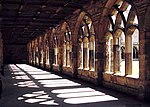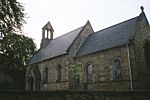Durham Cathedral

The Cathedral Church of Christ, Blessed Mary the Virgin and St Cuthbert of Durham, commonly known as Durham Cathedral and home of the Shrine of St Cuthbert, is a cathedral in the city of Durham, England. It is the seat of the Bishop of Durham, the fourth-ranked bishop in the Church of England hierarchy. The present Norman era cathedral had started to be built in 1093, replacing the city's previous 'White Church'. In 1986 the cathedral and Durham Castle were designated a UNESCO World Heritage Site. Durham Cathedral's relics include: Saint Cuthbert's, transported to Durham by Lindisfarne monks in the 800s; Saint Oswald's head and the Venerable Bede's remains. The Durham Dean and Chapter Library contains: sets of early printed books, some of the most complete in England; the pre-Dissolution monastic accounts and three copies of Magna Carta. From 1080 until 1836, the Bishop of Durham held the powers of an Earl Palatine. In order to protect the Anglo-Scottish border, powers of an earl included exercising military, civil, and religious leadership. The cathedral walls formed part of Durham Castle, the chief seat of the Bishop of Durham.There are daily Church of England services at the cathedral, Durham Cathedral Choir sing daily except Mondays and holidays, receiving 727,367 visitors in 2019.
Excerpt from the Wikipedia article Durham Cathedral (License: CC BY-SA 3.0, Authors, Images).Durham Cathedral
Dun Cow Lane, Durham Viaduct
Geographical coordinates (GPS) Address Website External links Nearby Places Show on map
Geographical coordinates (GPS)
| Latitude | Longitude |
|---|---|
| N 54.773611111111 ° | E -1.5761111111111 ° |
Address
Durham Cathedral
Dun Cow Lane
DH1 3ES Durham, Viaduct
England, United Kingdom
Open on Google Maps









